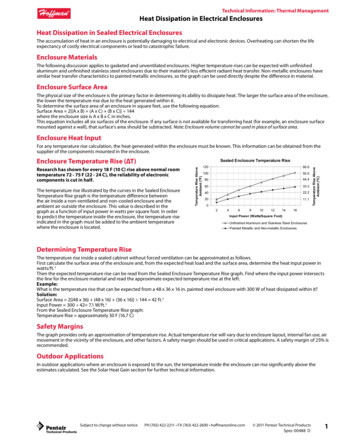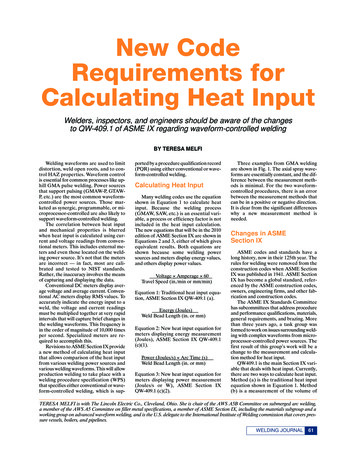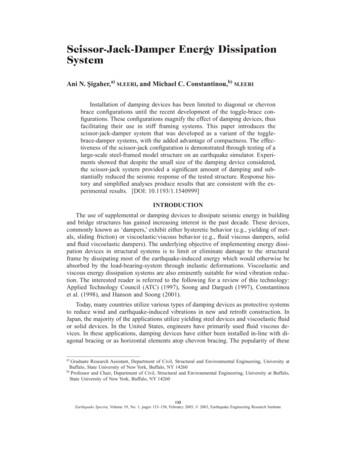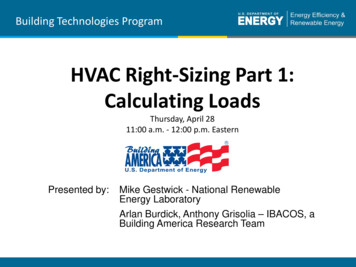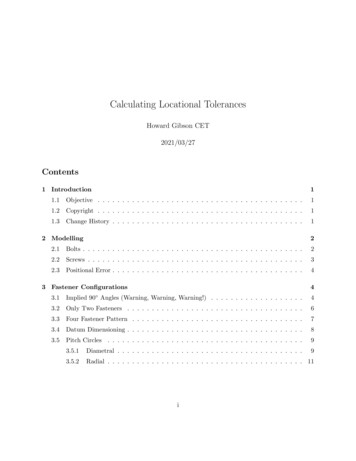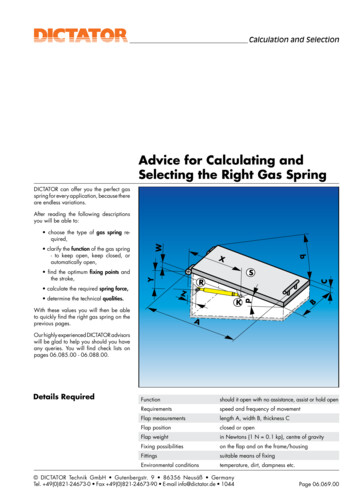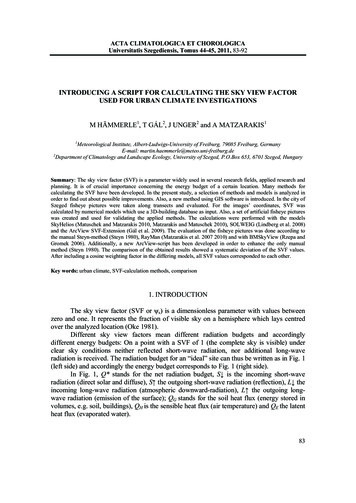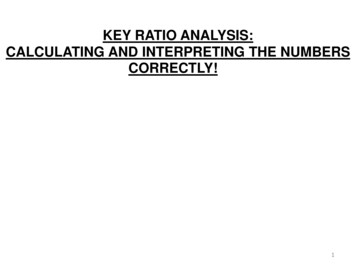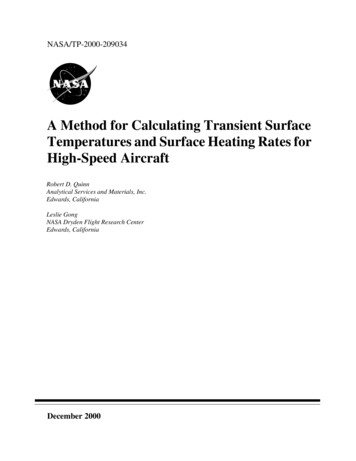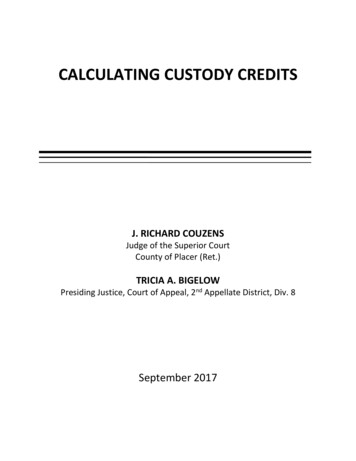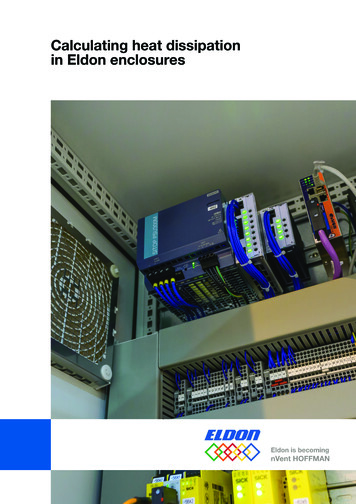
Transcription
Calculating heat dissipationin Eldon enclosures
Heat is the main reason for electronic component failure inside an enclosure. Theservice life of these components is halved, and the failure rate is doubled in the event ofa 10 K temperature increase relative to the maximum permitted operating temperature.Dealing with heat losses in enclosures depends on whether the enclosure is equippedwith cooling accessories, like filter fans and cooling units, and whether the enclosureis supposed to be “air tight”. For an enclosure that has cooling accessories installed,heat losses can be dissipated through active heat dissipation. If an enclosure has toremain closed without any cooling accessories, heat can only be dissipated throughthe enclosure walls.The most important factor in what type of heat transfer is possible is the maximumambient temperature at the enclosure location and the maximum temperature insidethe enclosure. The maximum temperature increase relative to the environment insidethe enclosure can be determined from the following equation:(Ti-Tu) Qv / (k*A)Where:QvTuTikA- Watts to dissipate- Ambient temperature- Permitted internal temperature- Heat transfer coefficient- Enclosure surface areaTo choose the most suited climate control solution for an enclosure, it is necessary tocalculate the heat loss, ‘Qv’, in the enclosure.The following parameters also need to be calculated.Qv - Heat loss installed in the enclosure (W)Qs - Thermal radiation via enclosure surface Qs k *A * TQk - Required useful cooling output (W) T - Temperature difference between inside and outside temperature (K) T (Ti-Tu)Qe - Required cooling output (W)Qe Qv - QsV- Required volumetric flow of fan and filter unit (m³/h)Approximate calculation V (3.1*Qv)/ T2 Calculating heat dissipation in Eldon enclosuresVisit our website at www.eldon.com 3
The maximum Internal enclosure temperature is determined by the electricalcomponents used in the enclosure. As far as the recommended internal enclosuretemperature is concerned, an average value of 35 C has become the norm.In addition, the enclosure surface area must also be determined according to theinstallation type.Enclosure installation type according to IEC 60 890Single enclosure, free standing on all sidesA 1.8 x H x (W D) 1.4 x W x DConclusions:The tables below show the amount of heat that is dissipated (W) through the enclosuresurface, when the ΔT is 20K. The temperature difference between the ambienttemperature and the maximum permitted internal temperature is then 20K:Ti (internal temperature) 45 CTu (Ambient temperature) 25 CSingle enclosure, for wall mountingA 1.4 x W x (H D) 1.8 x H x DΔT (Ti-Tu)ΔT 45-25ΔT 20KExampleFirst or last enclosure in a suite, free-standingA 1.4 x D x (W H) 1.8 x W x HFree standing enclosure, MCS18044R5Ti (internal temperature) 50 C,Tu (Ambient temperature) 40 C.ΔT (Ti-Tu)First or last enclosure in a suite, for wall mountingA 1.4 x H x (W D) 1.4 x W x DΔT 50-40ΔT 10KEnclosure Heat dissipation value according to the table below (when ΔT is 20K):310W310 / 20K 15,5WEnclosure within a suite, free standingA 1.8x W x H 1.4 x W x D H x D15,5 x 10K 155 WIf the ΔT 10K, the natural heat dissipation of a free standing MCS18044R5 is 155WAll data is calculated by using the formulas presented in this paper.If you find that the natural heat dissipation presented in these lists is not enough forthe enclosure application at hand, active cooling accessories may have to be installedin the enclosure. Such accessories could be filter fans, heat exchangers, or Vortexcoolers. Take the relevant information you have on your application and go to Eldon’swebsite and the thermal software there to calculate cooling, heating, and controlaccessory requirements.Enclosure within a suite, for wall mountingA 1.4 x W x (H D) H x DEnclosure within a suite, for wall mounting,covered roof surfacesA 1.4 x W x H 0,7 x W x D H x DThe following tables demonstrate the amount of heat that is dissipated through theenclosure surface.All data is calculated using formulas mentioned in this paper.If you need further assistance to determine your cooling, heating, and controlaccessory needs, please go to the Eldon website and use the Thermal software to helpyou with your climate calculation.4 Calculating heat dissipation in Eldon enclosuresVisit our website at www.eldon.com 5
Floor Standing EnclosuresSteel Range Mild Steel Combinable, Single Door MCSFloor Standing EnclosuresSteel Range Mild Steel Combinable, Double Door MCDW ( T 20 K)W ( T 20 R522008008007967187186416415635146 Calculating heat dissipation in Eldon enclosuresEnclosure1234Visit our website at www.eldon.com 7
Floor Standing EnclosuresSteel Range Mild Steel Compact, Single Door MKSFloor Standing EnclosuresSteel Range Stainless Steel Combinable, Single Door MCSSW ( T 20 K)W ( T 20 147950843639834567Floor Standing EnclosuresSteel Range Stainless Steel Combinable, Double Door MCDSW ( T 20 7234567Floor Standing EnclosuresSteel Range Stainless Steel Compact, Single Door EKSSW ( T 20 K)EnclosureFloor Standing EnclosuresSteel Range Mild Steel Compact, Double Door MKDW ( T 20 closure8 Calculating heat dissipation in Eldon 7Floor Standing EnclosuresSteel Range Stainless Steel Compact, Double Door EKDSW ( T 20 00729613700585671556516Visit our website at www.eldon.com 9
Floor Standing EnclosuresAluminium Range Aluminium Double Wall, Compact EKOMWall Mounted EnclosuresSteel Range Mild Steel Single Door MASW ( T 20 K)W ( T 20 00300MAS0352515R5350MAS0403015R5Floor Standing EnclosuresAluminium Range Aluminium Single Wall, Compact EKOM-SWW ( T 20 71166Floor Standing EnclosuresAluminium Range Aluminium Double Wall, Combinable ECOMW ( T 20 40R5120080040033429231327129225022510 Calculating heat dissipation in Eldon enclosuresVisit our website at www.eldon.com 11
Wall Mounted EnclosuresSteel Range Mild Steel Double Door MADWall Mounted EnclosuresSteel Range Stainless Steel Double Door ADRW ( T 20 K)W ( T 20 0
Heat is the main reason for electronic component failure inside an enclosure. The service life of these components is halved, and the failure rate is doubled in the event of a 10 K temperature increase relative to the maximum permitted operating temperature. Dealing with heat losses in enclosures depends on whether the enclosure is equipped with cooling accessories, like filter fans and .
